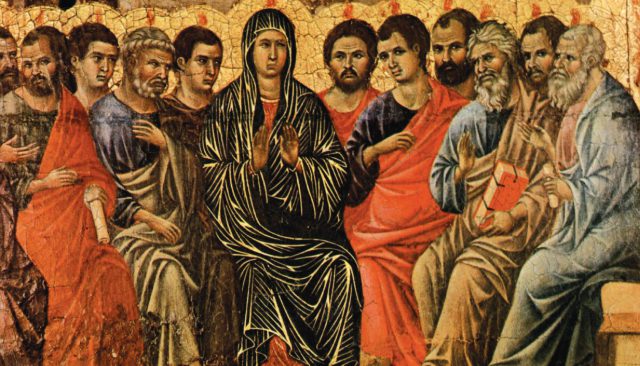
In my previous paper, I commenced a series on the Creeds of the Catholic Church. Having treated the Apostles Creed, I now turn to the Nicene Creed.
I will begin by reviewing the history of the Nicene Creed. I will include the Creed in the text and, finally, analyze the Creed.
History And Controversy
The Nicene Creed (or the Niceno-Constantinopolitan Creed) appears to have been a product of the Council of Constantinople in 381. However, it would not be officially stated until the Council of Chalcedon in 451.
The Creed was a response to several heresies promulgated in the early Church. Of particular concern is what came to be known as the Arian heresy. This heresy believed there was a “time” (the word time must be understood analogously since God exists outside of time) before Jesus existed, before He was begotten of the Father. Thus the Arian heresy taught that Jesus was the first-born of all creation, but only a creature – a godlike creature, but not God.
Ultimately, the Council of Nicea condemned the Arian Heresy and confirmed that Jesus was of the same substance (and essence) as God the Father. Still, the Nicene Creed would not be without controversy. The source of the dispute is what is known as the Filioque clause. The Filioque is a Latin term meaning “and the Son.”
The term is intended to express the procession of the Holy Spirit from the Father and the Son. While a complex issue, the Filioque controversy revolves around whether the Holy Spirit proceeds from the Father alone or from the Father and the Son. It is the teaching of the Catholic Church that the Holy Spirit proceeds from the Father and the Son.
Now, to the formulation of the Nicene Creed.
The Nicene Creed
“I believe in one God, the Father almighty, maker of Heaven and earth, of all things visible and invisible. I believe in one Lord Jesus Christ, the Only Begotten Son of God, born of the Father before all ages. God from God, Light from Light, true God from true God, begotten, not made, consubstantial with the Father; through him, all things were made. For us men and for our salvation, he came down from Heaven, and by the Holy Spirit was incarnate of the Virgin Mary, and became man. For our sake, he was crucified under Pontius Pilate, he suffered death and was buried, and rose again on the third day in accordance with the Scriptures. He ascended into Heaven and is seated at the right hand of the Father. He will come again in glory to judge the living and the dead, and his kingdom will have no end. I believe in the Holy Spirit, the Lord, the giver of life, who proceeds from the Father and the Son, who with the Father and the Son is adored and glorified, who has spoken through the prophets. I believe in one holy, catholic, and apostolic Church. I confess one Baptism for the forgiveness of sins, and I look forward to the resurrection of the dead and the life of the world to come. Amen.”
Analysis Of The Creed
For the purpose of analyzing the Nicene Creed, it is helpful to divide it into six articles.
Article 1. “I believe in one God, the Father almighty, maker of Heaven and earth, of all things visible and invisible.”
Article one confirms the Catholic belief in monotheism and establishes God as the Father of creation. Like the Apostles Creed, it was necessary to argue against the polytheism of paganism. The use of the Father to refer to the first Person of the Triune God is reflective of how Jesus refers to God (Matthew 6:9) as well as an indication of the personal nature of God.
Article 2. “I believe in one Lord Jesus Christ, the Only Begotten Son of God, born of the Father before all ages. God from God, Light from Light, true God from true God, begotten, not made, consubstantial with the Father; through him all things were made. For us men and for our salvation, he came down from Heaven.”
Jesus Christ, as the Son of God, is the Second Person of the Blessed Trinity. Jesus proceeds eternally from the Father and is one substance with God the Father. By stating that Jesus is “begotten, not made, consubstantial with the Father,” this article directly refutes the Arian heresy.
Article 3. “and by the Holy Spirit was incarnate of the Virgin Mary, and became man.”
God the Son became incarnate in the Person of Jesus of Nazareth. By virtue of being conceived by the Holy Spirit and being born of a virgin, God became a human being in Jesus. This article has ramifications concerning the economy of salvation, and it also serves to refute the Docetist heresy. Docetism claimed that Jesus was God but that He only appeared to become human and have a physical body. Catholicism teaches that Jesus was truly human.
Article 4. “For our sake, he was crucified under Pontius Pilate; He suffered death and was buried, and rose again on the third day in accordance with the Scriptures. He ascended into Heaven and is seated at the right hand of the Father. He will come again in glory to judge the living and the dead, and his kingdom will have no end.”
This article emphasizes that Jesus died for the sins of humanity. It also places Jesus’ suffering, crucifixion, and death into a historical context by referencing the Roman governor, Pontius Pilate.
Significant also is the claim that Jesus not only rose from the dead, but He did so of His own power. This, too, makes clear His Divinity. Moreover, Jesus rose in a physical and glorified body. By stating that Jesus rose in accordance with the Scriptures (e.g., Hosea 6:1-2 and Daniel 12:2), the Creed states that Jesus is the Messiah foretold of in the Old Testament.
Jesus’ ascension is even more evidence of His Divinity. In the ancient world, to be seated at the right hand of the King was not only a seat of honor but also meant that one was equal to the King. By stating that Jesus is seated at the right hand of the Father, the Creed again confirms Jesus as God.
Finally, the article predicates the Second Coming of Christ, the general judgment, and the ushering in of the Kingdom of God.
Article 5.“I believe in the Holy Spirit, the Lord, the giver of life, who proceeds from the Father and the Son, who with the Father and the Son is adored and glorified, who has spoken through the prophets.”
As the third Person of the Trinity, the Holy Spirit is correctly called Lord and the giver of life. The Holy Spirit is the breath of God that gives life and sustains life. The Holy Spirit is properly glorified and loved as God, along with the Father and the Son.
As mentioned above, the Filioque clause (and the Son) is intended to combat the Arian heresy. The Holy Spirit proceeds from the Father and the Son, but not in a generative sense. Instead, the Holy Spirit precedes as a spiration. Spiration means spirit or breath of God. The Father knows Himself (knowledge is logos in Greek). The Logos is the Son. As the Father knows Himself, He loves Himself, and that is the Holy Spirit.
Finally, this love of God as the Holy Spirit has spoken through the prophets of old and continues to speak through the Church today.
Article 6. “I believe in one, holy, catholic and apostolic Church. I confess one Baptism for the forgiveness of sins, and I look forward to the resurrection of the dead and the life of the world to come.”
The Creed concludes by referencing the four marks of the Church: that it is one, holy, catholic, and apostolic. Jesus founded one Church (Matthew 16:18). The Church is holy because Jesus is holy. The Church is catholic because its liturgy and teachings are uniform worldwide. The Church is apostolic because its origins and teachings date to the apostles. Moreover, there has been an unbroken line of Catholic bishops proclaiming the gospel.
Baptism is the sacrament whereby original sin is forgiven (Mark 16:15-16). As the sacrament leaves an indelible mark, it can only be done once.
The Creed reiterates the Biblical teaching of the resurrection of the body (2 Maccabees 7:9 and 1 Corinthians 15:13). Finally, the Creed professes our hope of eternal life in Heaven (i.e., the world to come).
Conclusion
In this work, I have sought to explain one of the Catholic Church’s most foundational statements of faith and a summary of orthodox belief, the Nicene Creed.
Not only does the Creed express the mystery of the Holy Trinity, but it is also a potent tool against heresy.












